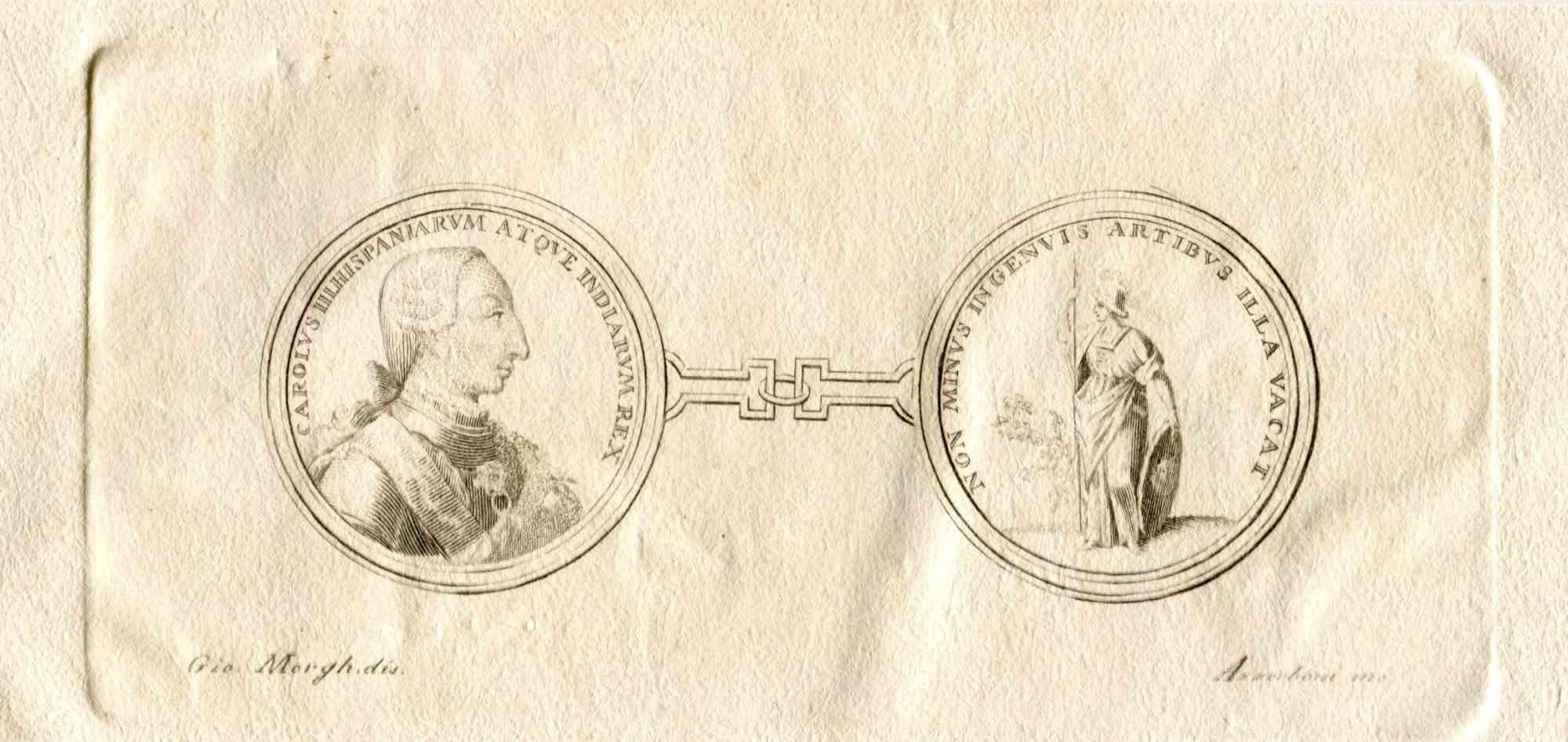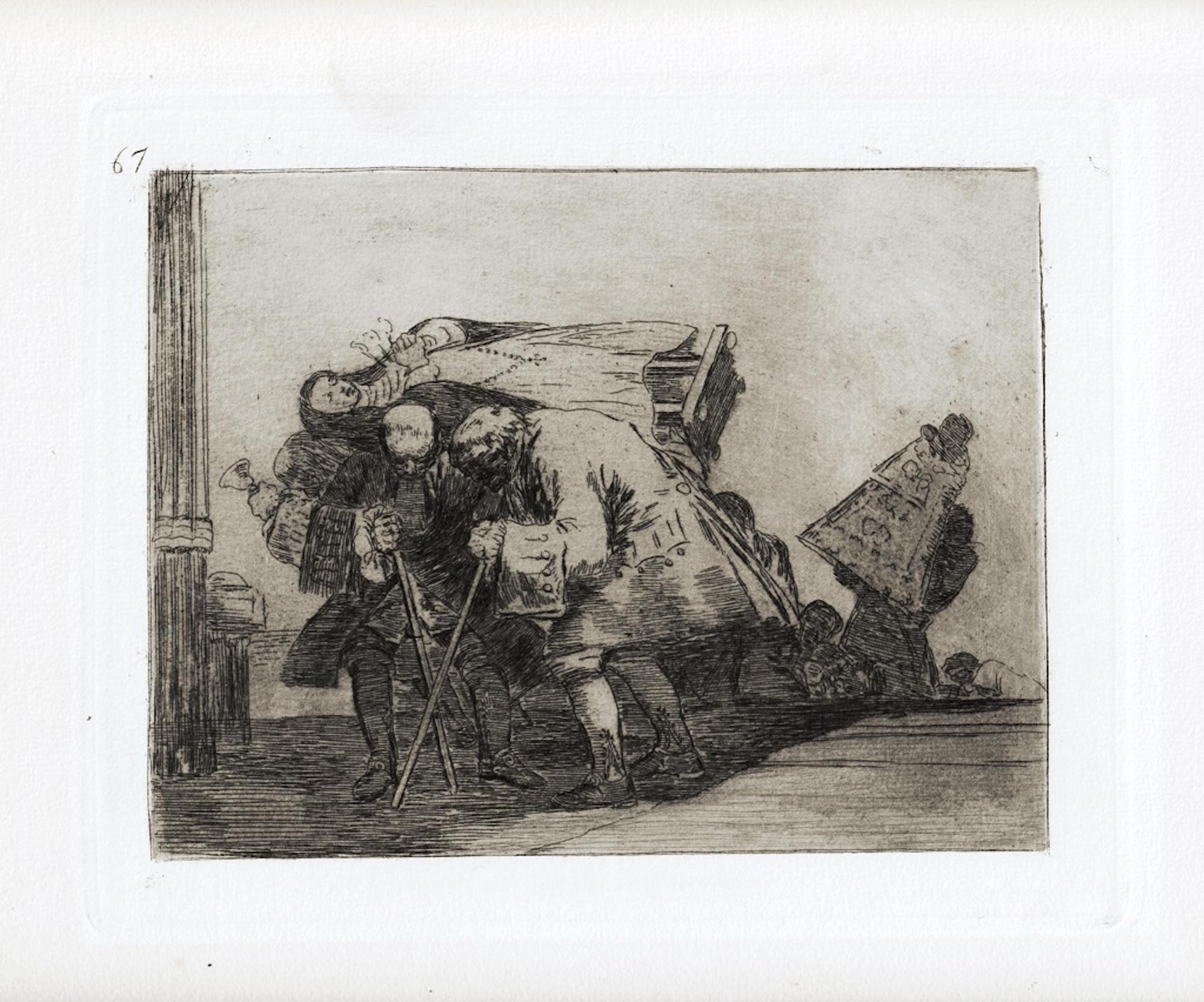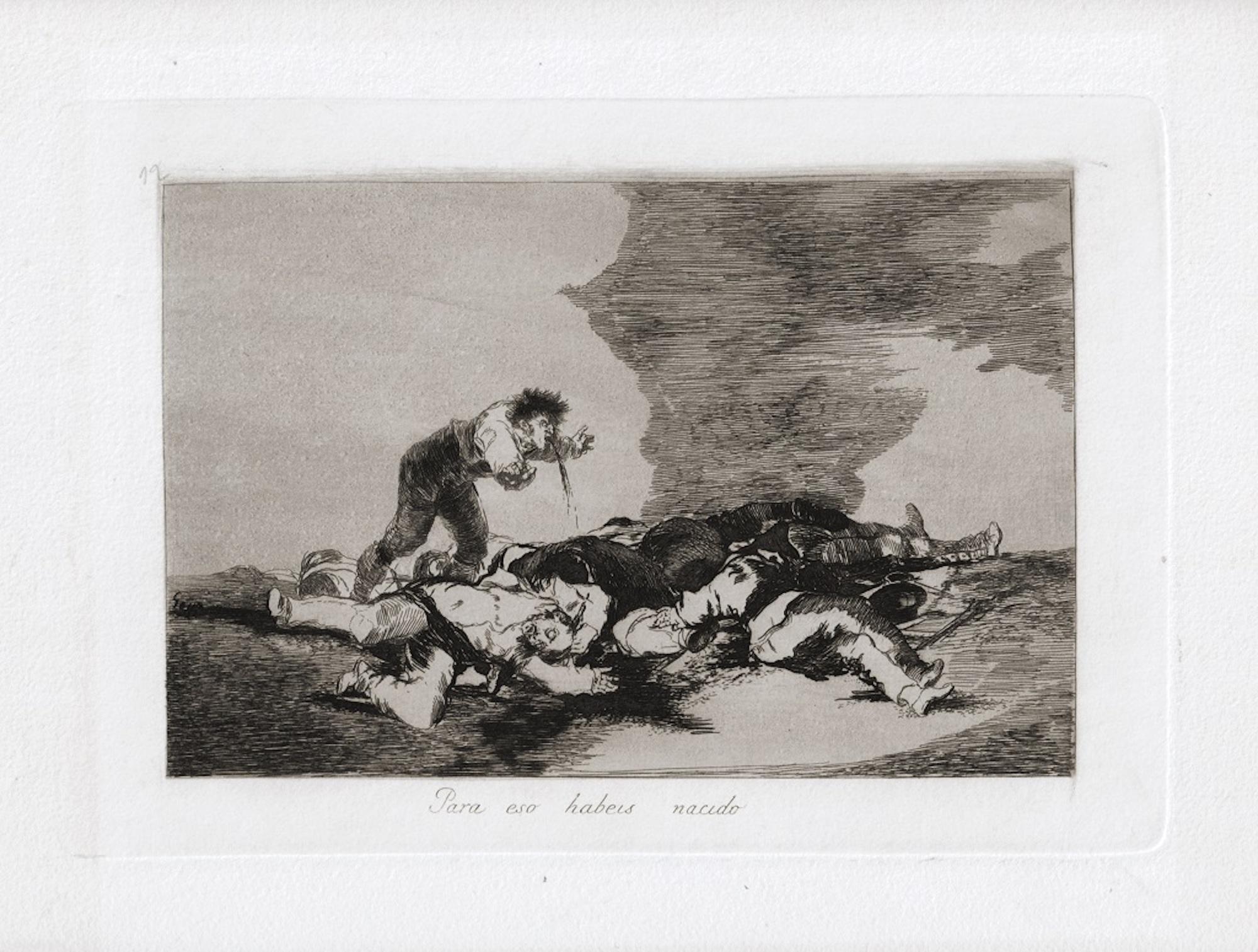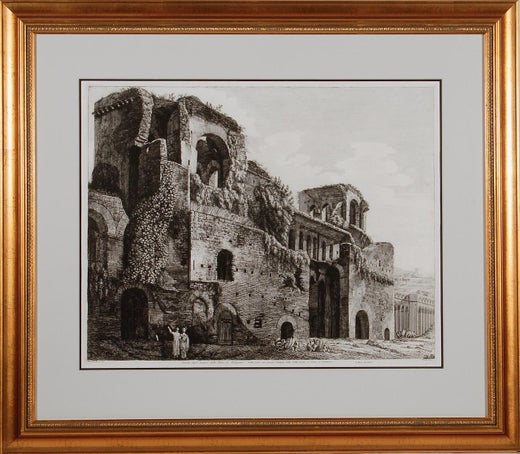Items Similar to 19th Century Etching of the Ancient Caracalla Baths in Rome by Luigi Rossini
Want more images or videos?
Request additional images or videos from the seller
1 of 11
Luigi Rossini19th Century Etching of the Ancient Caracalla Baths in Rome by Luigi Rossini1823
1823
About the Item
This early 19th century etching entitled "Veduta dei Grandi Avanzi delle Terme Antoniane, o di Caracalla" (The baths of Caracalla) was created by Luigi Rossini and included in his publication "Le Antichita Romane" (The Rome of Antiquity), published in Rome in 1823. It depicts the ruins of the historical Caracalla Baths as they appeared in the early 19th century. People are seen in the foreground giving perspective to the immense size of the ruins. One person in the open area between buildings appears to be shooting a rifle, perhaps target practice. The Baths of Caracalla were built in the early 3rd century by Emperors Septimius Severus and Caracalla (the son of Septimius Severus) and were in use until the 6th century. They were considered one of the wonders of ancient Rome. Much of the original building was destroyed in the earthquake of 847. Famous sculptures that once adorned the baths (over 120) include the Farnese Bull (the largest surviving sculpture from antiquity) and the Farnese Hercules.
The etching is presented in a black wood frame with a light brown outer mat and a dark brown inner mat. There are small spots in the right upper and mid portion of the print and three vertical light bands in the upper portion of the print. It is otherwise in very good condition. The print is framed and matted in the identical style as the another etching of an ancient Roman landmark, the Piazza Navona, which is also listed on 1stdibs, see item # LU117326144172. The pair would make an attractive display grouping of Roman architecture. A discount is available for purchase of the pair of prints.
Luigi Rossini (1790-1857) like his predecessors, Giovanni Piranesi (1720–1778) and Giuseppi Vasi (1710-1782), was an architect and artist. Like Piranesi and Vasi, he wanted to glorify the architecture of ancient Rome, which he felt was deteriorating and needed to be documented. Several of the ruins he illustrated have, in fact, since disappeared leaving only his images as a record of their appearance. His images of the grand edifices of the city dramatically depict the power and glory of ancient Rome reflected by its architecture, but were accurate enough to be used by practicing architects, as well as other serious students of classical antiquity. His art continues to influence and inspire architects, artists and those who love Rome.
Rossini was born in Rome and trained at the Academy of Bologna. Upon graduation, he moved to Rome and attempted a career as an architect. As he was not economically successful as an architect, he became a full-time artist, initially producing souvenirs for local collectors, wealthy and aristocratic European tourists on the Grand Tour, as well as for architectural students and practitioners all over Europe. Many of his prints were published in several imperial folio sized collections, including Le Anchita Romane (The Rome of Antiquity).
- Creator:Luigi Rossini (1790-1857, Italian)
- Creation Year:1823
- Dimensions:Height: 27 in (68.58 cm)Width: 29 in (73.66 cm)Depth: 1 in (2.54 cm)
- Medium:
- Movement & Style:
- Period:
- Condition:
- Gallery Location:Alamo, CA
- Reference Number:
Luigi Rossini
Luigi Rossini (1790-1857) like his predecessors, Giovanni Piranesi (1720–1778) and Giuseppi Vasi (1710-1782), was an architect and artist. Like Piranesi and Vasi, he wanted to glorify the architecture of ancient Rome, which he felt was deteriorating and needed to be documented. Several of the ruins he illustrated have, in fact, since disappeared leaving only his images as a record of their appearance. His images of the grand edifices of the city dramatically depict the power and glory of ancient Rome reflected by its architecture, but were accurate enough to be used by practicing architects, as well as other serious students of classical antiquity. His art continues to influence and inspire architects, artists and those who love Rome. Rossini was born in Rome and trained at the Academy of Bologna. Upon graduation, he moved to Rome and attempted a career as an architect. As he was not economically successful as an architect, he became a full-time artist, initially producing souvenirs for local collectors, wealthy and aristocratic European tourists on the Grand Tour, as well as for architectural students and practitioners all over Europe. Many of his prints were published in several imperial folio sized collections, including Le Anchita Romane (The Rome of Antiquity).
About the Seller
5.0
Gold Seller
These expertly vetted sellers are highly rated and consistently exceed customer expectations.
Established in 2011
1stDibs seller since 2019
242 sales on 1stDibs
Typical response time: 1 hour
- ShippingRetrieving quote...Ships From: Alamo, CA
- Return PolicyA return for this item may be initiated within 7 days of delivery.
More From This SellerView All
- Ancient Roman Architectural Frieze: An 18th C. Piranesi EtchingBy Giovanni Battista PiranesiLocated in Alamo, CAThis framed original 18th century etching is entitled "Fregio antico di marmo con Ippogrifi, nel cortile del palazzo della Valle" (Ancient Marble Frieze with Hippogriffs in the Courtyard of The Palace of the Valley). The etching is by Giovanni Battista Piranesi, published in Rome in 1778. It is from Piranesi's monumental work "Vasi, Candelabri, Cippi, Sarcofagi, Tripodi, Lucerne, Ed Ornamenti Antichi", (Vases, candelabra, grave stones...Category
Early 18th Century Old Masters Figurative Prints
MaterialsEtching
- Ancient Roman Marble Vase: 18th C. Piranesi Etching Vaso Cinerario di Gran MoleBy Giovanni Battista PiranesiLocated in Alamo, CA"Vaso Cinerario di Gran Mole. Le Teste dei Giovenchi mostrano di reggere it pesante Festone composto di Frutti Fiori Grans ed use. Il tuto Necefsario all Vita Umana. Il Restante degl...Category
1760s Old Masters Figurative Prints
MaterialsEtching
- Church of St. Costanza, Rome: An 18th Century Piranesi Architectural EtchingBy Giovanni Battista PiranesiLocated in Alamo, CAThis is a framed 18th century Giovanni Battista Piranesi etching entitled: "Veduta interna del Sepocro di Santa Costanza, fabbricat...Category
1770s Old Masters Interior Prints
MaterialsEtching
- Fabricius (Ponte Cestio) Bridge : Framed 18th C. Piranesi Architectural EtchingBy Giovanni Battista PiranesiLocated in Alamo, CAThis framed 18th century etching by Giovanni Battista Piranesi is entitled "Dimostransi nella Tav. presente la Pianta, ed Elevazione del Ponte, oggi detto Quattro Capi egli è antichissimo, e chiamavasi Fabrizio da L. Fabrizio Presid. delle Strade, che lo fabbrico' nel fine della Repubblica. "(The Plan and Elevation of the Bridge, today called Quattro Capi. The architect is very ancient, and was called Fabrizio da L. Fabrizio Presid. delle Strade, who built it at the end of the Republic). This is plate 18 in volume 4 of Piranesi's "Le antichita romane opera di Giambatista Piranesi architetto veneziano" (Roman antiquities by Giambatista Piranesi Venetian architect). It was published in Rome in 1756-1757. This etching depicts the plan and elevation of the bridge now called the Ponte dei Quattoro Capi or Ponte Cestio (Bridge of the Four Heads), which in antiquity was called the Bridge of Fabricius after L. Fabricius, the Superintendant of the Streets who built it at the end of the Republic, around 62 BC. It was also been known in the Middle Ages as ‘Ponte Giudeo’ (Bridge of the Jews). The bridge crossed from the left bank or northeast side of the Tiber River to Tiber Island...Category
1750s Old Masters Landscape Prints
MaterialsEtching
- Ruins of the Roman Baths of Belisarius: A 19th C. Etching by Luigi RossiniBy Luigi RossiniLocated in Alamo, CAThis early 19th century etching entitled "Veduta degl' Avanzi delle Torri di Belisario Dalla parte che guarda l' Interno della Città, vicino a Porta S. Giovanni, A. Mura Aureliane" (...Category
1820s Old Masters Landscape Prints
MaterialsEtching
- Column of Trajan in Rome: A Framed Original 19th C. Etching by Luigi RossiniBy Luigi RossiniLocated in Alamo, CAThis early 19th century etching entitled "Veduta dello scavo del Foro Trajano" was created by Luigi Rossini and included in his publication "Le Antichita Romane" (The Rome of Antiquity), published in Rome in 1823. It depicts the historical victory column of Trajan standing amidst the rubble of broken columns that remain around it. The etching is presented in a black wood frame with a light brown outer mat and a dark brown inner mat. There are several frame abrasions. The print and mats are in very good condition. The frame measures 27" high, 29.07" wide and 0.5" deep. The print is framed and matted in the identical style as the another etching of an ancient Roman landmark, the Piazza Navona, which is also listed on 1stdibs, see item # LU117326144172. The pair would make an attractive display grouping of Roman architecture. A discount is available for purchase of the pair of prints. Luigi Rossini (1790-1857) like his predecessors, Giovanni Piranesi (1720–1778) and Giuseppi Vasi (1710-1782), was an architect and artist. Like Piranesi and Vasi, he wanted to glorify the architecture of ancient Rome, which he felt was deteriorating and needed to be documented. Several of the ruins he illustrated have, in fact, since disappeared leaving only his images as a record of their appearance. His images of the grand edifices of the city dramatically depict the power and glory...Category
1820s Old Masters Figurative Prints
MaterialsEtching
You May Also Like
- Ancient Roman Fresco - Etching by Giovanni Morghen - 18th CenturyLocated in Roma, ITAncient Roman Fresco from the series "Antiquities of Herculaneum", is an original etching on paper realized by Giovanni Morghen in the 18th Century. Signed on the plate. Good condi...Category
18th Century Old Masters Figurative Prints
MaterialsEtching
- Principi Etruriae Duci - Etching by Charles Simonneau - Late 1600By Charles SimonneauLocated in Roma, ITPrincipi Etruriae Duci is an original artwork realized by the French artist Charles Simonneau in the second half of the XVII Century. Original Etching on paper. D'aprés Charles Le B...Category
Late 17th Century Old Masters Figurative Prints
MaterialsEtching
- Si Son de Otro Linage - Etching by Francisco Goya - 1863By Francisco GoyaLocated in Roma, ITSi son de otro linage is an original artwork realized by the great Spanish artist Francisco Goya in 1810. Original Etching on paper. The artwork belongs to the famous series "Los...Category
1860s Old Masters Figurative Prints
MaterialsAquatint, Etching
- De que Sirvé una Taza? - Etching by Francisco Goya - 1863By Francisco GoyaLocated in Roma, ITDi que sirvé una taza? is an original artwork realized by the great Spanish artist Francisco Goya in 1810. Original Etching on paper. The artwork belongs to the famous series "Lo...Category
1860s Old Masters Figurative Prints
MaterialsEtching, Aquatint
- Esta no lo es Menos - Etching by Francisco Goya - 1863By Francisco GoyaLocated in Roma, ITEsta no lo es menos is an original artwork realized by the great Spanish artist Francisco Goya in 1810. Original Etching on paper. The artwork belongs to the famous series "Los D...Category
1860s Old Masters Figurative Prints
MaterialsEtching, Aquatint
- Para es Habeis Nacido - Etching by Francisco Goya - 1863By Francisco GoyaLocated in Roma, ITPara es Habeis Nacido is an original artwork realized by the great Spanish artist Francisco Goya in 1810. Original Etching on paper. The artwork belongs to the famous series "Los Desastres...Category
1860s Old Masters Figurative Prints
MaterialsEtching, Aquatint
Recently Viewed
View AllMore Ways To Browse
Ancient Rome
6th Century
Pair Of Old Masters
Pair Of Etchings
Bull Sculpture Wood
Grand Tour Print
Hercules Sculpture
Antique Roman Emperor Sculpture
Bull Art Mid Century
Browning Rifle
Antique Wood Ruins
Roman Souvenir
Roman Emperors Framed
Full Size Sculpture Pair
Antique Earthquake
Old Baths
Grand Tour Emperor
Rossini Etching






